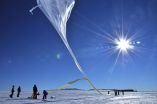(Press-News.org) HANOVER, N.H. - Potentially destructive high-energy electrons streak into Earth's atmosphere from space, not as Shakespeare's "gentle rain from heaven," but at velocities approaching the speed of light.
This particle onslaught can lead to ozone depletion and damage to the orbital satellites that provide us with the navigation, communication, weather, and military-recognizance information upon which we have become increasingly dependent. These satellites fly through the Van Allen radiation belts -- giant concentric layers of charged particles held in place by the Earth's magnetic field. An increase in particle density and charge brought about by solar activity can raise the level of threat to our critical satellites.
Dartmouth physicist Robyn Millan and a team of scientists have engaged in a unique study of this electronic bombardment, for the first time employing two distinctly different and distant vantage points high above the Earth.
Their findings appear in the journal Nature.
"This is exciting for us because we are integrating data collected by our instruments with the data from NASA's Van Allen Probes," says Millan, an associate professor of physics and astronomy. "These are the most direct measurements that have ever been made that link what's going on at the equator to what's coming into the atmosphere in the southern polar region. We are measuring particles that are getting scattered into Earth's atmosphere at the same time as the spacecraft are measuring what's going on in space."
Millan uses instruments carried aloft by balloons launched from Antarctica, rising as high as 125,000 feet. Supported by NASA, the project is called BARREL, an acronym for Balloon Array for Radiation belt Relativistic Electron Losses. The instruments record the X-rays produced as the falling electrons collide with the atmosphere.
"Earth's magnetic field looks like that of a bar magnet," Millan says. "If you follow from the equatorial plane down to the poles, particles move along those magnetic field lines. That's why we see the aurora in the northern and southern hemispheres."
The second source of information, also a NASA project, comprises the two Van Allen Probe satellites launched in 2012. The probes circle the Earth in eccentric orbits around the equator at altitudes of up to 20,000 miles. Flying in nearly identical eccentric orbits circling the Earth every nine hours, they cover the entire radiation belt region. The Van Allen radiation belts exist as two separate rings, with an outer one orbiting at a distance of some 8,000 to 40,000 miles, and an inner band at about 600 to 3,700 miles.
"Our paper looked at plasma waves," says Millan. "These are like sound waves in air except that now you are in an ionized gas so the electric and magnetic fields are affected."
Millan describes a solar flare that occurred in January 2014, releasing a burst of solar wind particles that hit and disturbed Earth's magnetic field. That created a particular kind of wave called "plasmaspheric hiss," examples of which have been observed for decades in the dense plasma region that encircles the Earth in the upper reaches of the atmosphere.
"What the paper shows is that we observed these waves at the location of the Van Allen probes. We saw electric and magnetic field variations that displayed a pattern, matching the variations in the X-rays we were recording in Antarctica," Millan says. "We concluded that those waves were causing the electrons to be scattered, yielding a new understanding of how the particles are getting kicked into the atmosphere. We are learning about processes that can affect our lives directly, when active in our planetary environment. These same processes are probably happening throughout the universe and, with the tools at our disposal, we can study them in detail right here."
INFORMATION:
Associate Professor Robyn Millan is available to comment at Robyn.Millan@dartmouth.edu.
Broadcast studios: Dartmouth has TV and radio studios available for interviews. For more information, visit: http://www.dartmouth.edu/~opa/radio-tv-studios/
A new guideline for the nutrition of management gastrointestinal symptoms in children with autism spectrum disorders (ASD) provides a framework for clinicians to navigate frequently seen issues such as food selectivity, alternative diets and nutritional deficits. The expert panel was convened at Marcus Autism Center, an affiliate of Children's Healthcare of Atlanta and the resulting guideline was published online by the Journal of the Academy of Nutrition and Dietetics (JAND).
"Children with autism are at increased risk for feeding and gastrointestinal (GI) concerns compared ...
PROVIDENCE, R.I. [Brown University] -- Brown University computer scientists have developed a new interactive tool to help researchers and clinicians explore the genetic underpinnings of cancer.
The tool -- dubbed MAGI, for Mutation Annotation and Genome Interpretation -- is an open-source web application that enables users to search, visualize, and annotate large public cancer genetics datasets, including data from The Cancer Genome Atlas (TCGA) project.
"The main motivation for MAGI has been to reduce the computational burden required for researchers or doctors to ...
How much does diet affect the cancer patient? Do "antioxidants" really play an important role in health - or are they causing more cancers than they cure? And what exactly is the relationship between obesity and cancer?
The latest Special Issue in ecancermedicalscience collects four original articles from experts in cancer and metabolism, addressing the hottest areas of research in this rapidly developing field.
"In our clinical practice, cancer patients often ask 'Doctor, is there something specific I should eat or avoid eating?'" says Guest Editor of this Special ...
The brain's effect on other parts of the body has been well established. Now, a group that includes two University of Florida Health researchers has found that it's a two-way street: Body fat can send a signal that affects the way the brain deals with stress and metabolism.
While the exact nature of those signals remains a mystery, researchers say simply knowing such a pathway exists and learning more about it could help break a vicious cycle: Stress causes a desire to eat more, which can lead to obesity. And too much extra fat can impair the body's ability to send a ...
Many of the same genes may affect GCSE results across a broad range of subjects according to a new study from the Institute of Psychiatry, Psychology & Neuroscience at King's College London.
The research, published today in Scientific Reports, also suggests that educational achievement at GCSE is highly heritable, with over half of the difference between results potentially due to inherited differences in DNA.
Previous studies have shown that academic achievement in the core subjects of English, mathematics and science at GCSE may be influenced by the same genetic traits. ...
Philadelphia, PA, July 23, 2015 - Posttraumatic stress disorder (PTSD) and traumatic brain injury (TBI) can have devastating consequences. Both are associated with high rates of disability and suicide, and although they are separate conditions, they commonly co-occur. For example, a soldier who has developed PTSD as a result of a traumatic experience may have also sustained a brain injury during that experience.
Significant research has been conducted to understand the brain mechanisms underlying PTSD and TBI, but there has still been a lack of knowledge regarding exactly ...
New research by health scientists at the University of York has revealed that a greater proportion of men than women suffer from cannabis psychosis.
There has been much research exploring the nature of the relationship between cannabis -- the most widely used illicit drug in the United Kingdom -- and psychosis, however the role of gender in relation to cannabis psychosis is less well explored and understood.
A new study by researchers in the Department of Health Sciences at York used large datasets over a period of 11 years to investigate the differences in men and ...
A new drug that blocks cancer's escape route from chemotherapy could be used to treat deadly lung and pancreatic cancers, new research reports.
Scientists have shown in human cancer cells and in mice that the drug - discovered at The Institute of Cancer Research, London - boosts the effectiveness of conventional chemotherapy.
The drug, known as CCT245737, is scheduled to begin first-in-human clinical trials in patients with lung and pancreatic cancers - two cancers with low survival rates that continue to resist currently available treatments.
The new study is published ...
A team of researchers from the University of Leicester and France's G2ELab-CNRS in Grenoble have for the first time observed the growth of free nanoparticles in helium gas in a process similar to the decaffeination of coffee, providing new insights into the structure of nanoparticles.
Nanoparticles have a very large surface area compared with their volume and are often able to react very quickly. This makes them useful as catalysts in chemical reactions and they are often used in sports equipment, clothing and sunscreens.
In a paper published by the Journal of Physical ...
Contact between children and fathers following parental separation facilitates the continued abuse of women and children, according to new research focusing on the experiences of families with a prior history of domestic abuse conducted by social work experts at Trinity College Dublin.
The research, which explored the experiences of post-separation fathering in families with prior history of domestic abuse perpetrated by the father against the mother, involved the completion of survey questionnaires 219 mothers regarding their 449 children as well as face-to-face interviews ...

